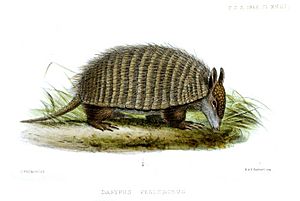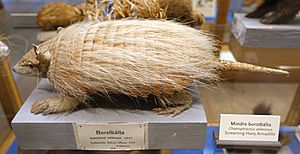Screaming hairy armadillo facts for kids
The screaming hairy armadillo (Chaetophractus vellerosus) is a small type of armadillo found in central and southern South America. It's also known as the small screaming armadillo, crying armadillo, or small hairy armadillo. This armadillo gets its "screaming" name because it makes a loud squealing sound when someone picks it up. It lives underground, digging burrows in dry areas.
Quick facts for kids Screaming hairy armadillo |
|
|---|---|
 |
|
| Conservation status | |
| Scientific classification | |
| Genus: |
Chaetophractus
|
| Species: |
vellerosus
|
 |
|
| Screaming hairy armadillo range | |
| Synonyms | |
|
|
Contents
What Does It Look Like?

This armadillo is one of the smallest in its group. It has longer ears compared to other armadillos of its kind. Male armadillos are usually about 33 to 40 centimeters (13 to 16 inches) long. Females are a bit smaller, ranging from 26 to 42 centimeters (10 to 16.5 inches).
Males typically weigh around 860 grams (about 1.9 pounds), but can be between 543 and 1329 grams (1.2 to 2.9 pounds). Females weigh about 814 grams (1.8 pounds) on average, with a range of 257 to 1126 grams (0.6 to 2.5 pounds).
These armadillos have more hair than many other armadillo species. Their shell, called a dorsal shield, has 18 bands, and six to eight of these bands can move. The hair on their back is light brown.
Where Do They Live?
The screaming hairy armadillo lives in dry areas, from low lands to high mountains. You can find them in parts of Argentina, Bolivia, and Paraguay, especially in regions like the Gran Chaco and Pampas. There's also a separate group living in eastern Buenos Aires Province in Argentina.
They prefer places like dry forests, shrublands, and grasslands. They also live in hot and temperate deserts, and sometimes even in farms or plantations. They avoid rocky areas because they need soft ground to dig their burrows.
How Do They Behave?
These armadillos are active at different times depending on the season. In summer, they are mostly active at night. But in winter, they are more active during the day. They can go for a long time without needing water.
They often dig their burrows at the bottom of bushes or shrubs. They have many burrows in their home area, and each burrow might have more than one entrance. When an armadillo is inside a burrow, it usually seals the entrance. A burrow can be 20 to 38 centimeters (8 to 15 inches) wide and several meters long. They don't build a special nest inside their burrows.
What Do They Eat?
When they are not in their burrows, screaming hairy armadillos spend most of their time looking for food. They are omnivorous, meaning they eat both plants and animals. Their diet includes insects, small animals like lizards and frogs, and plant material, especially pods from Prosopis trees. What they eat can change a lot depending on the season.
In winter, they gain weight, adding a layer of fat about 1 to 2 centimeters (0.4 to 0.8 inches) thick under their skin. This helps them survive. They eat a lot of sand while they are looking for food. Sometimes, sand can make up half the volume of their stomach!
Reproduction and Life Cycle
The mother armadillo carries her babies for about 60 to 75 days. Young armadillos become old enough to have their own babies when they are about 9 months old. They can have two litters of babies each year.
Armadillos and People
In some parts of the Gran Chaco region in Bolivia, people hunt these armadillos for their meat. Sometimes, farmers see them as a nuisance because they dig in fields, and they might be hunted by dogs. The group of armadillos living near the coast in Buenos Aires Province, Argentina, is affected by mining activities in their area. The armadillo's hard shell is also used to make charangos, which are musical instruments similar to a small guitar.
See also
 In Spanish: Piche llorón para niños
In Spanish: Piche llorón para niños




